Dr. K’s Weekly Roundup, November 14, 2025
Not to be missed!
Exclusive on Pelican+, Saturday, November 15: a documentary called “The Great Indoctrination,” on what happened to education in the West and how this trend can be reversed.
Pre-show: 6:30 pm ET
Premiere: 7:00 pm ET
Post-show: 8:15 pm ET
Links here.
Interview & review
Gaetano Masciullo interviewed me on my new book, His Reign Shall Have No End: Catholic Social Teaching for the Lionhearted:
Donald Goodman reviews the same book at the website of the Confraternity of Christ the King.
Good News
Loosening restrictions on the TLM
The big news this week is that the papal nuncio to Great Britain told the gathered bishops of England and Wales that any one of them who requests an extension on the TLM will receive it from Rome, no questions asked.
As Kevin M. Tierney remarked, that’s probably the beginning of the end of Traditiones Custodes. Michael Matt is also reporting that TLMs have come back to the side altars at St Peter’s. It’s as if we’re seeing the first thaw of spring.
Let me be clear: none of this is yet a “solution.” Bishops don’t have to ask, and if they are hostile, they won’t. But it is a first step toward a solution. It doesn’t give immediate aid to Catholics whose TLMs have been canceled, but it does push open the door for a rethinking and eventual replacement of TC.
Regarding how to “read” Leo XIV, I recommend Joseph Shaw’s latest newsletter to the International Una Voce Federation. Shaw speaks with a great deal more common sense and good judgment than many folks out there in the commentariat. And yet… I don’t think he’d entirely disagree with the respectful reproofs leveled by Fr. John Perricone in “Holy Father, Help Us to Understand.”
Also well worth reading is Dom Alcuin Reid’s “Pope Leo and the sacred Liturgy: what will he do?” in The Catholic Herald.
It’s always good to be reminded that, as Robert Lazu Kmita explains, only God’s authority is unlimited; certainly, the pope’s is not, and the recognition of its limits is a key to maintaining both tradition and sanity in these times.
New dedicated parish for TLM in Brooklyn
While the genius of Summorum Pontificum was to bring the TLM right into the heart of ordinary parishes where, like the radiant sun, it exercised a beneficent influence on everyone (and we certainly need to get back to that, and eventually beyond it to something even better), it has become clear for now that the best and safest way for laity to build their lives on the rock of tradition is to live near a fully dedicated traditional oratory, shrine, chapel, or personal parish run by the Priestly Fraternity of St. Peter, the Institute of Christ the King, the Institute of the Good Shepherd, or other such community. A large part of the benefit is that one has not only Mass in the old rite, but all the sacraments, and much else besides.
Thus, it is always immensely good news to hear about the founding of a new traditional parish (or quasi-parish) of this kind. From Rorate:
The parish of Saint Josaphat in Bayside, Queens [N.B.: we celebrate his feast today, November 14, in the usus antiquior] has been transferred into the care of the ICKSP. Bishop Robert Brennan graciously invited the Institute to run the parish as a way to continue it being a home for the TLM in the Diocese of Brooklyn. It is now formally known as Saint Josaphat’s Oratory in Queens, and the ICKSP has updated their locations list.
This coming Sunday at 9:30am, Monsignor Gilles Wach will celebrate a Solemn High Mass there with Canon Talarico and Canon Hellman to mark this great moment for the community.
The TLM was already being offered for some time at Saint Josaphat’s, but now it will be run full time as a focal point of the Traditional Roman Rite, traditional catechesis, and traditional Catholic life in general in Long Island.
New President of USCCB
Prayers for Archbishop Paul Coakley, a student of John Senior’s, who this week was elected the new president of the USCCB. He’s been a long-time supporter of Wyoming Catholic College, which he visited more than once.
Above, a delightful picture of some of Senior’s old students, reunited at a conference for Catholic liberal education, and reprising what Senior, Nellick, and Quinn would do—having a well-informed, intelligent conversation on the dais while the audience soaks it in. On the right: Bishop Conley; in the middle, Archbishop Coakley, the new president of the USCCB; to the left, Alan Hicks Tom Foster:
Sacred music graduate program
We have been waiting for this for a long time: a robust graduate school program in Sacred Music. Thanks be to God, to Archbishop Cordileone, and to Jennifer Donelson, it is now here. Applications open November 18, 2025. The faculty is stellar. Read more here.
Regina magazine special issue
Speaking of sacred music: the latest issue of the always-beautiful Regina Magazine is now out, and it’s the most spectacular yet. The whole issue is dedicated to music. Interviews with me,1 Jennifer Donelson, Peter Carter, Nicholas Lemme, Floriani, and much else besides. You can obtain your copy at this link. Think of picking up copies for friends and open-minded clergy.
Monks on the silver screen…
I encourage you to watch this short, beautiful new video about the life and mission of the Benedictine Monks of Perpetual Adoration of Silverstream Priory in Ireland. I am happy to call many of them my friends. It’s been too long since my last visit but I look forward to going again someday.
Scholarship opportunity
Courtesy of Matt Fradd:
Big announcement—My friends at the College of St. Joseph the Worker (Steubenville, OH) are offering an amazing opportunity for you listeners. If you apply, and are accepted into their program, you will have a chance at a $5,000 scholarship, awarded through a short essay contest. That’s a huge portion of your first year tuition—which is already shockingly affordable! You’ve heard me talk about this college many times before, so if you’re ready for a truly special education, go to collegeofstjoseph.com/apply and start your application today.
As a further bonus, you can use code MATTSCLASS and they’ll waive the application fee for you!
To be eligible for the scholarship, you must apply by Nov. 30, 2025: collegeofstjoseph.com/apply
Synodality fatigue
As James Green discusses, even the liberal papers are starting to talk about “synodality fatigue.” One more sign that all this nonsense is heading where it was always fated to go: the dustbin of irrelevancy.
Marian Titles Revisited
From a learned priest friend—probably the best overall take on the recent Doctrinal Note Mater Populi Fidelis from the DDF that I have yet seen:
In the back-and-forth responses to the recent instruction on Marian titles, what I found remarkable is that a couple of key issues were not being addressed.
(1) First, the oddity that the doctrinal exposition in that document of Our Lady’s role in the redemption and in the economy of grace is actually very good. As an experiment, you could retain all of the doctrinal-biblical exposition unchanged and use that to support the titles of Co-Redemptrix and Mediatrix of All Graces. What those titles mean is what the text says is true Marian doctrine. All you’d have to do is introduce the instruction with this sentence: “The titles of Co-Redemptrix and Mediatrix of All Graces, long used by popes and saints and by many of the faithful, are to be understood in the following sense, so as to avoid any misunderstanding on the part of the Catholic faithful and of other Christians who seek to understand the Catholic Church’s Marian doctrine.”
In this regard, the instruction is very odd. It’s like listening to someone who defends kingship and royal prerogatives but rejects being referred to as a “monarchist.” If the instruction’s doctrinal teaching is correct, then it follows that the titles of Co-Redemptrix and Mediatrix of All Graces are fitting. The stated Marian doctrine does not cohere with a universal negative judgment on the title of Co-Redemptrix. Mediatrix is of course harder to reject, unless one wishes to reject Vatican II’s Lumen Gentium.
The DDF is primarily concerned with doctrine. Its doctrinal teaching, unless clearly in contradiction to earlier teaching, should generally be received respectfully. Disciplinary and prudential statements in a document such as this are not on the level of doctrine.
Yet there is a logical problem in saying that it is “always” inappropriate to call Mary Co-Redemptrix. That is a universal statement that seems to apply under all circumstances (not merely, for example, to our own time and to the efforts for Christian unity and mutual understanding). Many popes and saints have defended this title. Were they all wrong?
Where would a curial official receive the authority to censure popes and saints and doctors of the Church? If the response is that Cardinal Fernandez receives such authority from the reigning Pope Leo XIV, then the text would have to be approved “in forma specifica.” It wasn’t.
(2) Second, this instruction infringes on the spiritual freedom of the faithful and of theologians. Cardinal Ratzinger did not think it opportune to define another Marian dogma, but he never censured the faithful who wished to invoke the Mother of God under these titles. It’s inaccurate to give the impression that he “opposed” those titles. Newman thought it inopportune to define papal infallibility, but he did accept the definition itself.
There was simply no reason to take any action at all on this matter. I have no difficulty in accepting and defending these two titles, but I never thought they should be dogmatized or that the faithful must accept them (as, for example, they accept de fide Our Lady as Mother of God and her Immaculate Conception). It also never occurred to me that so many millions of Catholics should have their Marian piety seemingly censured with this cold blast from the DDF.
This is particularly annoying when it comes from people who claim to be so very pastoral and to care so much for the sensus fidelium and for freedom in all lawful matters, within the unity of faith.
Well said!
An Italian Mariologist has offered an in-depth analysis of Mater Populi Fidelis, the new doctrinal note from the Dicastery for the Doctrine of the Faith, arguing that it adopts a minimalist view of the Blessed Virgin Mary and risks halting—or even reversing—the theological development of Marian soteriology, that is, the understanding of Mary’s role in salvation.
According to Fr. Serafino Maria Lanzetta, Mater Populi Fidelis (MPF) represents “a significant downgrade” not only from the teaching of the saints, doctors, and ordinary magisterium of the popes, but also from the Second Vatican Council’s treatment of Mary’s role in salvation as presented in Chapter 8 of the dogmatic constitution on the Church, Lumen Gentium.
Fr. Lanzetta is the real deal as far as Marian theologians go (and this is often true of Franciscans). Os Justi Press has published two books by him: Super Hanc Petram: The Pope and the Church at a Dramatic Moment in History, and his little gem of a primer, God’s Abode with Man: The Mystery of Divine Grace.
Bishop Athanasius Schneider has also weighed in: “They Could Not Have Been Mistaken: The Voice of the Saints, Doctors, and the Ordinary Magisterium of the Church in Affirming Mary as ‘Co-Redemptrix’ and ‘Mediatrix of All Graces.’”
Political Speculations
Transbyebye?
At First Things, “The Collapse of Trans Identification,” Jonathon van Maren explains that the number of young people identifying as transgender, nonbinary, queer, or anything but straight has dropped off dramatically in the several years since “peak woke” (around 2021 to 2023). This accords with the observation that transgenderism is a social contagion, following boom and bust cycles. He concludes, “Trans identification will continue to collapse. The only question is how far, and how much damage this social contagion will leave in its wake.”
Kingsnorth goes south?
Just a couple of days ago, my wife and I finished reading together (aloud) Paul Kingsnorth’s Against the Machine. From a literary point of view, it was most enjoyable. It had many moments of piercing insight and moving testimonial; for contemporary cultural critique, especially of AI, it’s hard to beat. However, my main criticism would be that the author’s philosophical foundations are not sufficiently deep, and his account of the West — particularly when it comes to the root causes of what he is calling “the Machine” — is too simplistic. Two good reviews have been published, a rather favorable one by Michael Hanby, and a withering takedown by Rousseau scholar Emily Finley, whose work at The Christian Imagination I’ve often praised.
Morello’s twins
One of Finley’s most salient criticisms is that Kingsnorth appears to be wholly ignorant of the rich Western conservative tradition from Burke to Kirk and beyond, as he writes off “conservatives” as no better than liberals. That’s certainly true of the fake conservatives, but there are real ones too (call them “paleo” if you wish). A fine example of a modern-day inheritor of the true conservative mantle is Sebastian Morello, who has just published two books that I can recommend unstintingly:
Unto the Ages of Ages: Essays on Political Traditionalism (Arouca Press, 2025)
Woodland Philosophy: Meditations on Hunting, Hiking, and Holiness (Angelico Press, 2025)
At the blog of the Society of St. Hugh of Cluny, Stuart Chessman offers a review of the first of these.
Liturgical Lessons
Holy Week in Spain
The Mass of the Ages film crew has begun an ambitious series of filmings around the world about Catholic traditions that have endured to the present and what we can learn from them. If the Holy Spirit is the soul of the Church, Tradition is the soul of the Catholic religion.
Scott Hahn on the living Word
Jesus didn’t say “write this in memory of me”—He said “do this.” And that one word makes all the difference in the world. In a conversation with Gavin Ashenden, Scott Hahn provides a wonderful synopsis of his explanation of the Mass as the meaning of the book of Revelation (and indeed of all of written revelation), pointing toward the definitive wedding feast of the Lamb.
Did I make a mistake?
Rorate Caeli has published a powerful letter written to Bishop Michael Martin by a Protestant convert to Catholicism who lives in the diocese of Charlotte. This man converted largely because he was drawn in first by the majesty and mystery of a more traditional liturgy, and only later did his mind open to the doctrine and to the need to join the Church. He says that the way Bishop Martin speaks and acts makes it seem as if the Protestants were right all along. An amazing letter; please read it.
What contemplative life needs
A religious sister sent me the following message, which is similar to what I’ve heard from hundreds of religious over the decades. At a certain point in her life she needed to stay for a period of time at a monastery that featured the TLM, which she had never seen before:
I said to my spiritual father: “I don’t know how I am going to do this Latin thing.” He replied: “Approach it in a contemplative way and I am sure you will not look back!” I took his advice and a couple of weeks later I found myself in quite a confused space. Clarity came with much soul searching and questions along the lines of “What happened to the Mass?” And “How did we get here?” I had very little experience of the TLM and was slightly left of the side of indifference. How I describe that period of my life is one of being “washed over” or “drawn in” by the experience. It seemed to respond to something I had long been looking for without knowing it. Early on in my religious life I would often think, “If Holy Mass is the source and summit of my faith, I must be doing something wrong (neglecting my faith, not nourishing my faith in the Eucharist, etc.) because there is something missing,” and now, here I was experiencing the TLM and coming to the realisation that “THIS is what was missing.”
Leaving aside the question of the laity for the moment, I submit that it is not difficult to see why the TLM is immeasurably superior for priestly and religious life. Of the pieces I’ve written on that topic, the most substantial was published at NLM: “Traditional Liturgy Attracts Vocations, Nourishes Contemplative Life, and Sustains the Priesthood.”
Gregorian chant in Chinese
Gregory DiPippo presents some amazing examples of Gregorian chant adapted to Chinese by the Belgian priest Fr Frédéric-Vincent Lebbe (1877–1940).
In Fr Lebbe’s time, the Church had not yet made the great leap forward into the deleterious modern understanding of inculturation, in which the liturgy is absorbed by the culture of the surrounding society. Rather, the culture of each society, the best of it, was put into the service of the liturgy, but it was a given, as it always had been, that the liturgy itself was received by the local church along with the Faith from the church that evangelized it. Fr Lebbe therefore set a large portion of the Roman liturgy to Chinese, while retaining the original liturgical forms, literary content and music as far as possible.
Folks in the DC area
Don’t miss Fr. Perricone’s visit to the Capitol! Open to the public. The Arlington Latin Mass Society offers this advice:
Enter at the south door of the United States Capitol (the side closest to Independence Avenue). You will need to go through security, and an ALMS volunteer will escort you to the event. The event will begin promptly at 6:30 p.m., so please arrive a few minutes early.
Thanks for reading, and may God bless you!
My interview was also published here at the Substack.



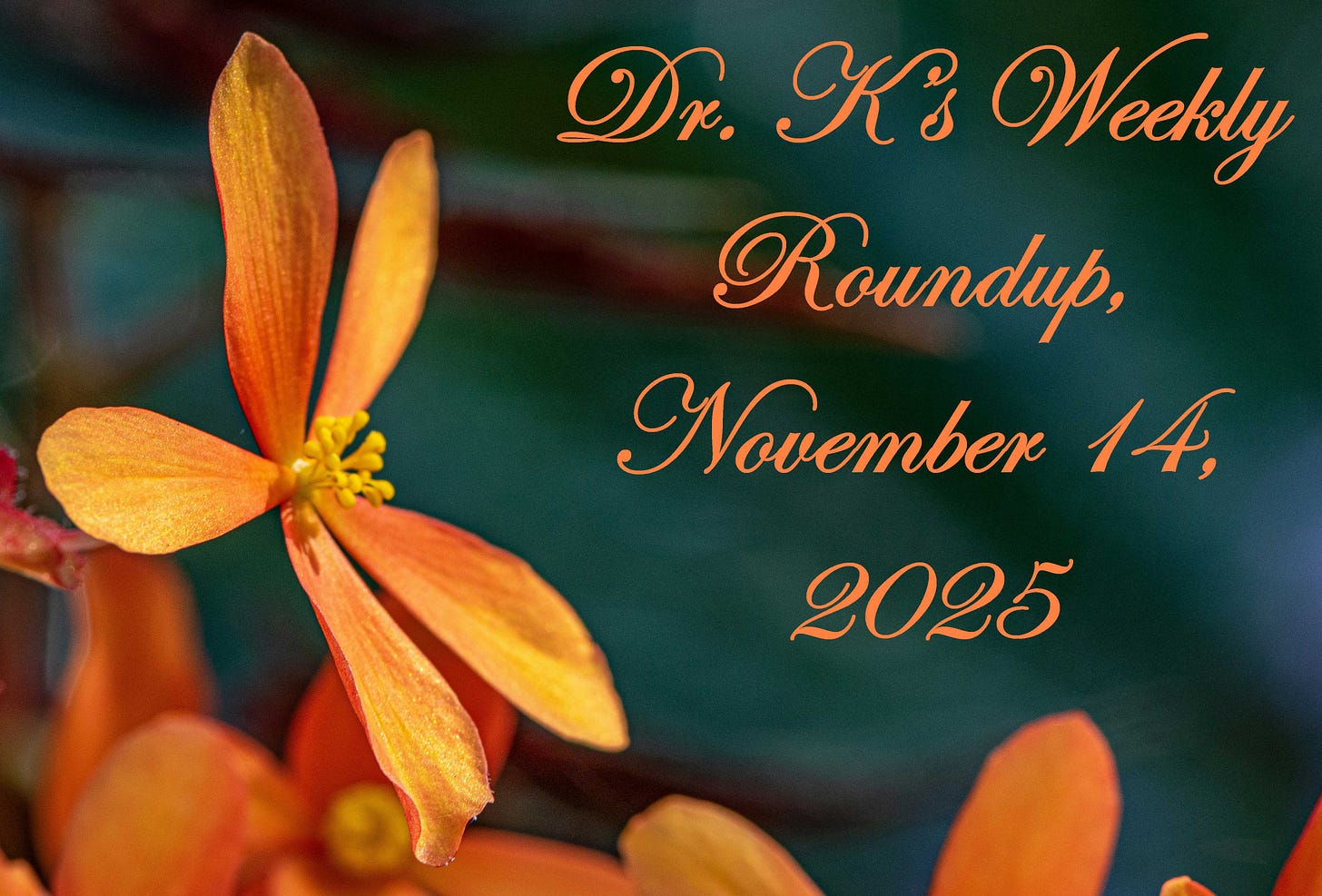
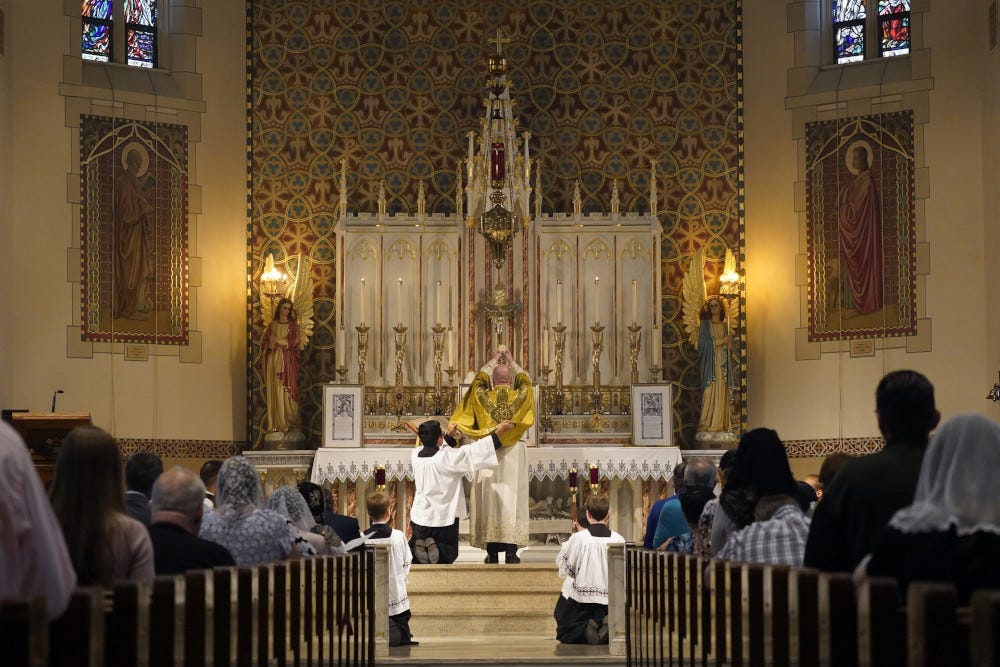
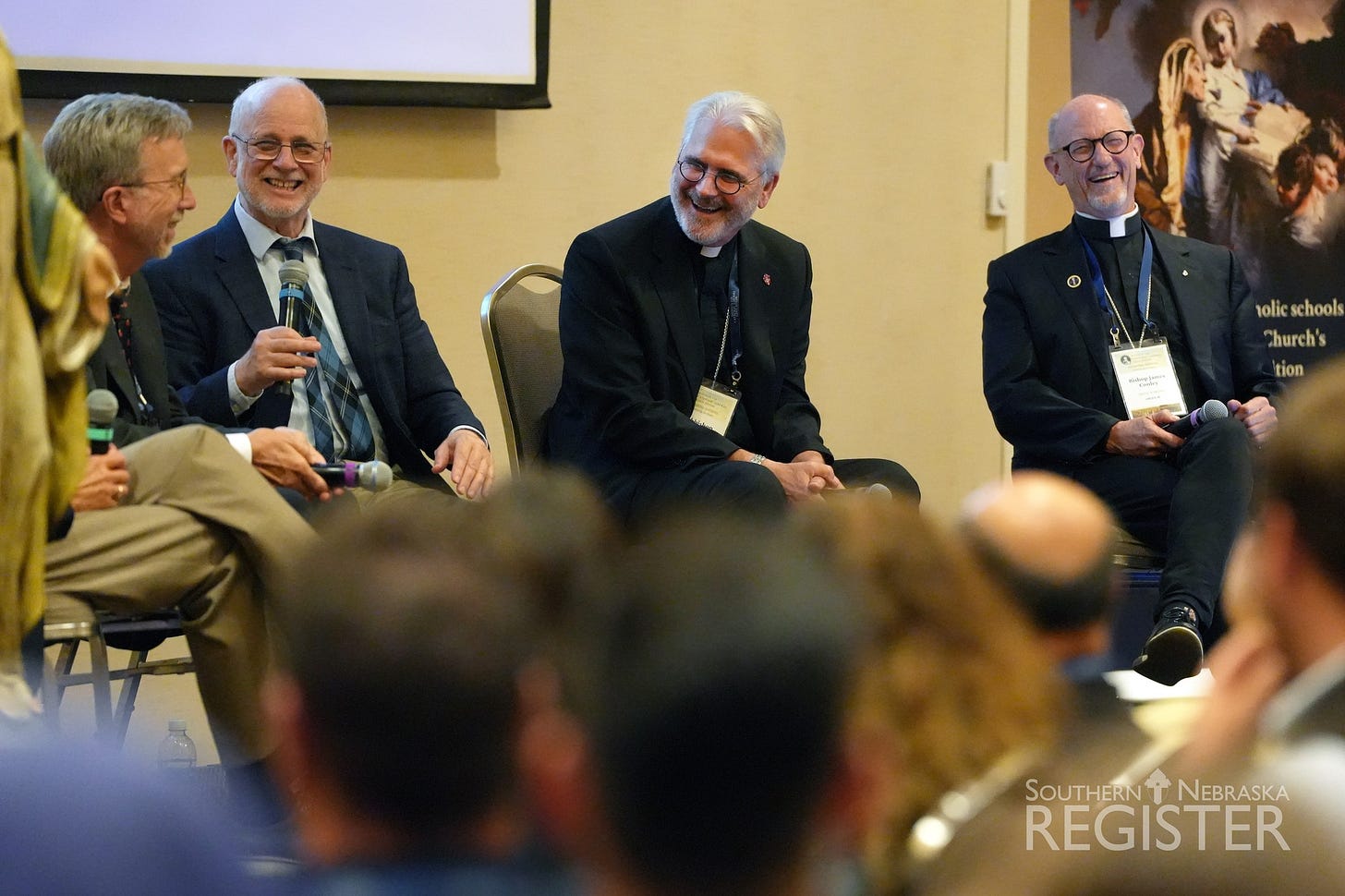
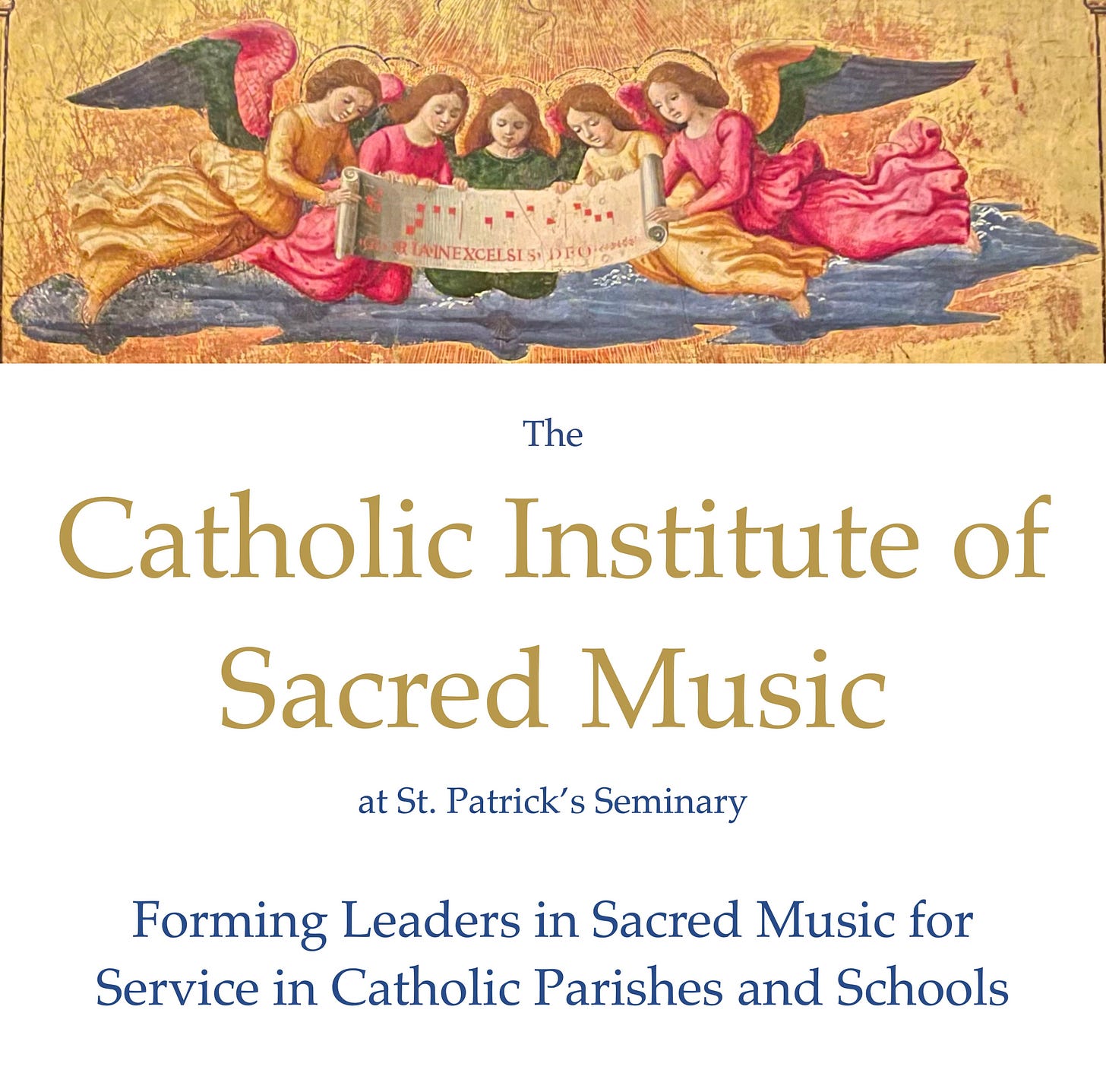

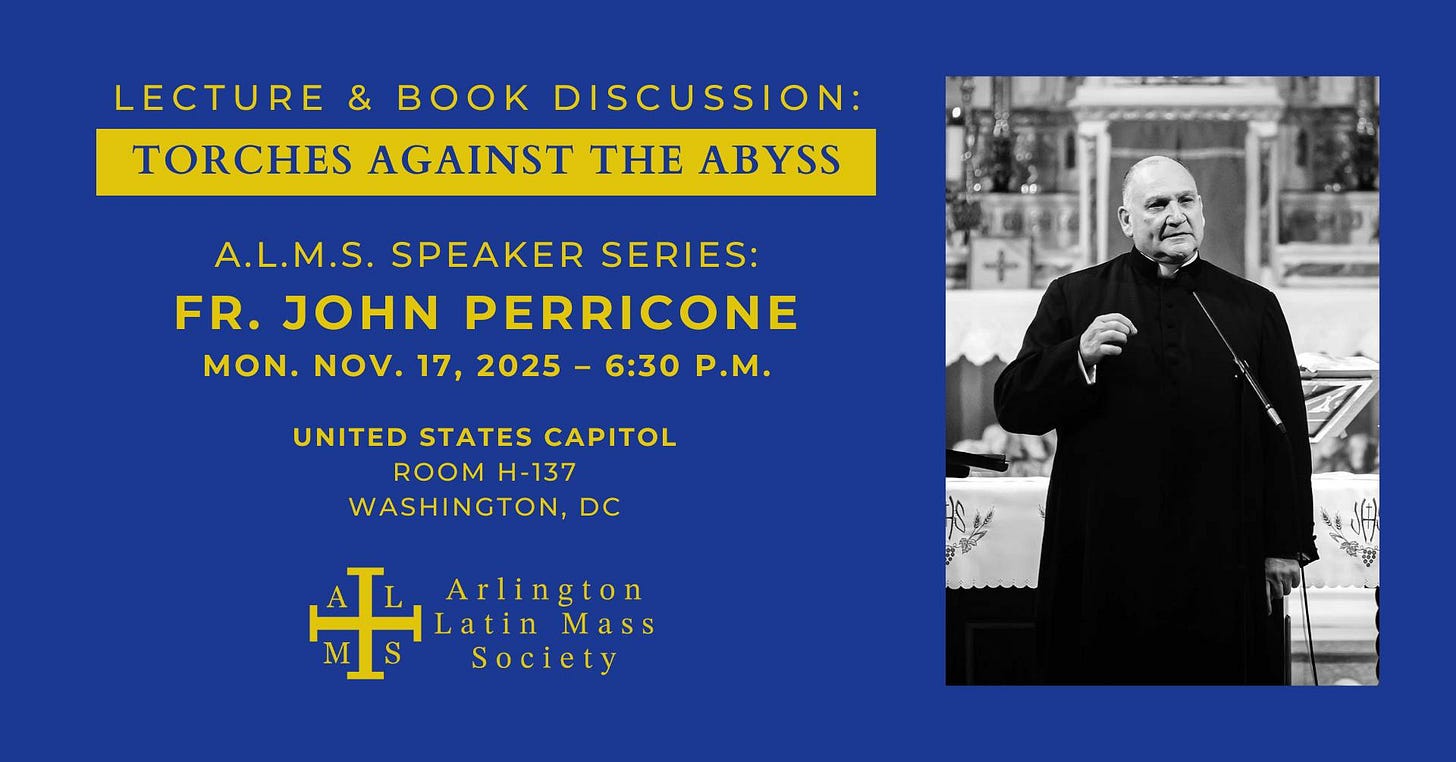
Thanks for the great content!